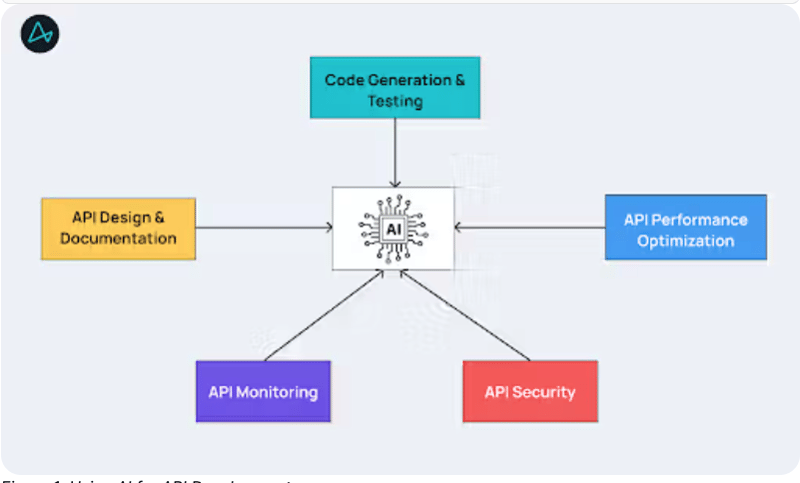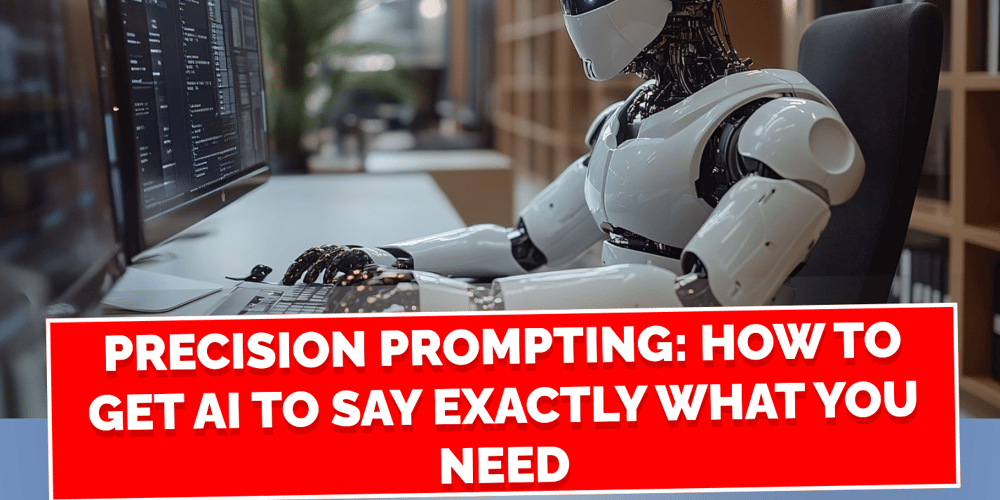Using AI for API Development
Many modern applications depend on APIs. These apps use APIs to exchange data and connect to vital services and resources. Basically, without APIs, most software we rely on wouldn't work. Given the importance of APIs, it's no surprise that API development is a big deal. However, building APIs is a complex process. It involves designing, securing, and maintaining them. This process can be slow and has real limitations. But what if AI could change that? What if it made API development quicker and simpler? You've likely seen how AI can assist with coding. Well, AI for APIs goes even further. It can generate tests, suggest code, or even write it for you. For every bit of the API development process, there's a way to involve AI, and this can make a big difference. In this article, we'll explore how AI can help you build APIs faster and better. We'll look at the benefits of using AI in API development and also some of its challenges. By the end, you'll have a good idea of how AI can transform the way you build APIs. The role of AI in API development AI can do a lot when it comes to building APIs. For starters, AI can help write code, generate tests, and even create API documentation or specs from simple prompts. It can also play roles in design, security, and maintenance, making each part of the process a little easier. Basically, wherever there's a task in API development, AI has a way to pitch in. Blackbird API Development Platform Blackbird automates tasks like dummy code creation for mocking and provides a maintenance-free, hosted environment for live API testing. Figure 1: Using AI for API Development Traditionally, you'd spend hours or days writing code line by line, manually conducting API testing for every edge case, and tweaking specs by hand. With AI, a lot of that gets automated. Take testing, for example; there are AI-powered tools with features that allow you to generate test scripts for your API endpoints in seconds. Compared to manually crafting tests, it's clear that AI saves time and cuts down on human error. So, what's the payoff? One of the greatest benefits of using AI is its capacity to scale. If you could typically manage 10 API endpoints without AI, you could handle 100 or more when you integrate it into your workflow. This means you can build APIs faster, with fewer bugs, and with less stress. AI-driven API design and documentation At the initial phase of the API development process is the API design and documentation of your API. This is where you outline what your API will do, how it will work, and what data it will handle. With AI, you can speed up this process. AI tools can help you turn natural language prompts into API specifications. You can literally say something like, "I need an API that fetches user data by ID," and AI tools—powered by large language models—can spit out a structured spec, say in OpenAPI format, ready to roll. Using AI for API documentation. AI can automate the whole process, pulling details from your code or specs to create clear, accurate documents—and even keep them updated as your API evolves. Compare that to the old way of painstakingly writing docs by hand and hoping they don't fall out of sync the next time you tweak something. AI takes that load off and keeps everything tight and current. AI in API code generation and testing Once your API's design and docs are set, it's time to write the code and test it. This is where AI can really shine. With AI code generation, you can build API endpoints faster. How it works is simple: you tell an AI tool what you need, say, "Create an endpoint to update a user's profile," and it generates the code for you. It might spit out the routes, logic, and even error handling in your preferred language, ready to plug in. No more starting from a blank page. AI in API testing AI can also automate API testing, with AI-driven test case generation and execution. Instead of manually writing tests for every possible scenario, there are AI tools that can analyze your API, figure out what needs testing, and crank out test cases. Then, it runs them for you, flagging what passes or fails. It's way quicker than doing it all by hand. To top it off, there's self-healing test automation. This is where AI gets smart about debugging and fixing errors. If a test fails because your API changed—as an endpoint's response format shifted—an AI tool can spot the issue, adjust the test to match, and even suggest code fixes. AI for API performance optimization Once your API is up and running, keeping it fast and reliable becomes the name of the game. In this phase, AI can help you optimize performance. It can analyze your API's usage data, spot bottlenecks, and suggest tweaks to make it faster. For example, it might notice a slow endpoint and recommend caching results or trimming bulky database queries. It could also suggest compressing responses to save ba

Many modern applications depend on APIs. These apps use APIs to exchange data and connect to vital services and resources. Basically, without APIs, most software we rely on wouldn't work. Given the importance of APIs, it's no surprise that API development is a big deal.
However, building APIs is a complex process. It involves designing, securing, and maintaining them. This process can be slow and has real limitations. But what if AI could change that? What if it made API development quicker and simpler?
You've likely seen how AI can assist with coding. Well, AI for APIs goes even further. It can generate tests, suggest code, or even write it for you. For every bit of the API development process, there's a way to involve AI, and this can make a big difference.
In this article, we'll explore how AI can help you build APIs faster and better. We'll look at the benefits of using AI in API development and also some of its challenges. By the end, you'll have a good idea of how AI can transform the way you build APIs.
The role of AI in API development
AI can do a lot when it comes to building APIs. For starters, AI can help write code, generate tests, and even create API documentation or specs from simple prompts. It can also play roles in design, security, and maintenance, making each part of the process a little easier. Basically, wherever there's a task in API development, AI has a way to pitch in.
Blackbird API Development Platform
Blackbird automates tasks like dummy code creation for mocking and provides a maintenance-free, hosted environment for live API testing.
Figure 1: Using AI for API Development
Traditionally, you'd spend hours or days writing code line by line, manually conducting API testing for every edge case, and tweaking specs by hand. With AI, a lot of that gets automated.
Take testing, for example; there are AI-powered tools with features that allow you to generate test scripts for your API endpoints in seconds. Compared to manually crafting tests, it's clear that AI saves time and cuts down on human error.
So, what's the payoff? One of the greatest benefits of using AI is its capacity to scale. If you could typically manage 10 API endpoints without AI, you could handle 100 or more when you integrate it into your workflow. This means you can build APIs faster, with fewer bugs, and with less stress.
AI-driven API design and documentation
At the initial phase of the API development process is the API design and documentation of your API. This is where you outline what your API will do, how it will work, and what data it will handle.
With AI, you can speed up this process. AI tools can help you turn natural language prompts into API specifications. You can literally say something like, "I need an API that fetches user data by ID," and AI tools—powered by large language models—can spit out a structured spec, say in OpenAPI format, ready to roll.
Using AI for API documentation. AI can automate the whole process, pulling details from your code or specs to create clear, accurate documents—and even keep them updated as your API evolves. Compare that to the old way of painstakingly writing docs by hand and hoping they don't fall out of sync the next time you tweak something. AI takes that load off and keeps everything tight and current.
AI in API code generation and testing
Once your API's design and docs are set, it's time to write the code and test it. This is where AI can really shine. With AI code generation, you can build API endpoints faster.
How it works is simple: you tell an AI tool what you need, say, "Create an endpoint to update a user's profile," and it generates the code for you. It might spit out the routes, logic, and even error handling in your preferred language, ready to plug in. No more starting from a blank page.
AI in API testing
AI can also automate API testing, with AI-driven test case generation and execution. Instead of manually writing tests for every possible scenario, there are AI tools that can analyze your API, figure out what needs testing, and crank out test cases. Then, it runs them for you, flagging what passes or fails. It's way quicker than doing it all by hand.
To top it off, there's self-healing test automation. This is where AI gets smart about debugging and fixing errors. If a test fails because your API changed—as an endpoint's response format shifted—an AI tool can spot the issue, adjust the test to match, and even suggest code fixes.
AI for API performance optimization
Once your API is up and running, keeping it fast and reliable becomes the name of the game. In this phase, AI can help you optimize performance. It can analyze your API's usage data, spot bottlenecks, and suggest tweaks to make it faster.
For example, it might notice a slow endpoint and recommend caching results or trimming bulky database queries. It could also suggest compressing responses to save bandwidth. These are small changes that add up to a snappier API.
Then, there's AI-driven traffic monitoring and anomaly detection, which keeps your API steady under pressure. AI tools can watch incoming requests in real-time, flagging weird patterns—like a sudden spike in errors or a flood of unusual traffic that might signal an attack. This way, you don't have to stare at logs all day, waiting for an issue to pop up.
Based on your past usage trends, you usually set up load balancing and scaling rules. However, AI can take this a step further with predictive scaling and load balancing. It can predict when your API will get slammed—like during a big sale or a viral moment—and scale resources up ahead of time. It can also balance loads across servers to keep things smooth.
Enhancing API security with AI
APIs are powerful, but they're also targets. Keeping them secure is critical, and AI can make a big difference here.
First up is AI-powered threat detection and mitigation. Without AI, you'd rely on manual rules like blocking IPs after X failed attempts, which can miss sneaky attacks or lag behind new threats. AI can analyze traffic patterns, spot odd behavior like a flood of requests from one source, and flag or block them in real time.
Next, there's AI in API authentication and authorization. Take OAuth flows, for example. Normally, you'd set up static checks to catch bad logins, but that can miss subtle issues—like a legitimate token being misused.
AI can step in with anomaly detection, watching how tokens are used and catching outliers, like a sudden spike in access from an unusual location. Without AI, you might be stuck reacting after the damage; with it, you're catching problems as they start.
Then, there are automated compliance checks. Without AI, ensuring your API meets security best practices like OWASP guidelines means manually auditing configs and code, which is slow and error-prone.
AI flips that. It can scan your API setup, check for weak spots, for example, missing rate limits or unencrypted data, and flag them instantly. It even keeps you aligned with standards as rules evolve.
AI for API lifecycle management and monitoring
Usually, when managing your API lifecycle, you would manually track API versioning, guess when to phase out old ones, and hope users keep up. AI changes that. It can analyze usage data—like which endpoints are still popular or ignored—and suggest when to roll out a new version or sunset an old one. It even predicts how changes might impact users, so you are not flying blind.
Then, there is real-time API monitoring with AI-powered analytics. Instead of just logging stats and checking them later, AI watches your API live. It crunches data on latency, errors, or traffic spikes and flags issues—like a sudden slowdown—before they snowball. This way, you're fixing problems as they happen, not after users notice them.
Finally, AI chatbots and virtual assistants can handle API support and maintenance. Got a user stuck on an error? An AI chatbot can troubleshoot it—say, explain a 400 Bad Request—or guide them through docs, all without you stepping in. For maintenance, it can monitor logs, spot recurring bugs, and even suggest fixes.
Using AI for the entire API development process
We've gone through various phases where AI can play a role in enhancing the development of your API. For each phase, there's an AI tool or platform that can help you automate tasks, speed up development, and keep your API secure and optimized. Choosing tools to explore these advantages could take a lot of time. There are certainly many ways to go about it and much depends on the area where you need the most support.
One option is to try a tool that incorporates AI in the API development process in multiple stages, for example, Blackbird. Blackbird is an AI-powered API development platform that covers various stages of the API lifecycle.
Blackbird uses AI to turn your ideas, like "I need an API to fetch customer orders" into OpenAPI specs in seconds. When it's time to code, Blackbird's AI-powered code generation whips up endpoints and boilerplate, so you're not stuck writing the same stuff over and over.
When it comes to API testing it allows you to create mocks that let you simulate your endpoints instantly, no backend required. Your team can test ideas and integrations early, cutting out delays. And, if you’d like to set test automation, including integrating with other AI technology, headless authentication does the trick for now, with more built-in features to come.
In my experience, Blackbird has a user-friendly interface along with an easy-to-navigate CLI tool, allowing seamless access to its features. It’s a platform that allows you to incorporate AI into your API development workflow simply and easily.
The challenges and limitations of using AI in API development
Now, we've gone through how you can use AI in various stages of the API development process and see that it can take off a lot of the difficult, error-prone tasks in each of the stages.
However, AI is certainly not perfect. So, in this section, we'll go through some important considerations when using AI in API development:
1. Ethical considerations in AI-generated code
When AI writes your endpoints or specs, who's accountable if it introduces bias—like favoring certain data patterns—or spits out code that's unintentionally insecure? Plus, there's the question of ownership: if an AI tool pumps out a chunk of your API, is it really "yours"? These aren't just tech problems—they're ethical gray areas that require thought and planning to avoid business and even legal ramifications.
2. Limitations in AI's understanding of business logic and context
AI can crank out code or tests based on patterns it's seen, but it doesn't truly “get” your app's unique needs. Say your API handles sensitive healthcare data—AI might miss the nuance of compliance rules or customer expectations unless you spoon-feed it the details. It's great at the how but shaky on the “why,” so you can't just let it run wild without filling in those gaps. This is where, when it comes to APIs, great specs can be an extremely helpful starting point.
3. Risks of over-reliance on AI and the need for human oversight
It's tempting to rely heavily on AI for speed, letting it generate, test, and optimize everything—but relying on it too much can backfire. If you stop double-checking its work, you might miss bugs, security holes, or just plain bad decisions that the AI tool didn't catch. You must think of AI as a super-smart assistant, not a replacement. Human eyes still need to stay in the loop to keep things on track.
The future of AI in API development
So, where's AI taking API development next?
For one, AI is getting smarter at predicting what developers need. Think of tools that don't just suggest code but anticipate entire API workflows based on your app's goals. We're also seeing AI go deeper into optimization, like auto-tuning APIs for specific industries, whether it's health care or IoT.
Then, there's the mashup of AI with low-code and no-code platforms. There are platforms that are already making API creation accessible to non-coders, letting anyone drag and drop their way to a working endpoint. Add AI into the mix, and it's next-level: the AI can suggest integrations, auto-generate connectors, or even debug on the fly.
Imagine a small business owner saying, "I need an API to sync my shop with Stripe," and the platform, powered by AI, just makes it happen. It's democratizing APIs in a way we haven't seen before.
The combination of these trends means API development could soon be less about coding and more about intent. AI will handle the heavy lifting specs, code, testing, scaling—while low-code/no-code opens the door for anyone to join in. It's a future where APIs aren't just for devs but for anyone with an idea, and AI is the engine driving it all forward.
Conclusion
We've covered a lot of ground here. APIs are the backbone of modern apps, but building them the old way is slow and tricky. You can use AI in every phase, from whipping up specs and code to boosting security, optimizing performance, and managing the lifecycle.
Sure, it's not perfect; there are ethical questions, limits to what AI understands, and the need to keep humans in the loop, but the benefits are hard to ignore. Looking ahead, AI's only getting smarter, blending with low-code platforms to make APIs accessible to everyone, not just coders.
Whether you get started trying a platform like Blackbird or another tool, the benefits of integrating AI into the API development workflow are available.














































































